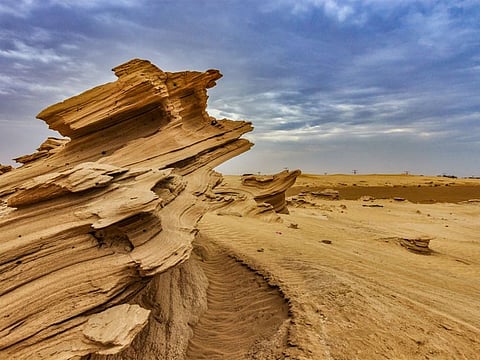Abu Dhabi: EAD to open Al Wathba Fossil Dune Protected Area for visitors from Saturday
Public will have the opportunity to visit 1,700 rare fossil dunes

Abu Dhabi: An expanse filled with stunning fossil dunes has been added to Abu Dhabi Emirate’s Protected Areas network, which will allow it to be preserved for future generations.
The Al Wathba Fossil Dunes Protected Area, located 45km east of Abu Dhabi city, will open to visitors on Saturday, February 5.
It was inaugurated on Tuesday by Sheikh Hamdan bin Zayed Al Nahyan, Ruler’s Representative in Al Dhafra Region, and chairman of the board of directors at the emirate’s environment regulator, the Environment Agency - Abu Dhabi (EAD).
There are 1,700 fossil dunes in Al Wathba, densely located over seven square kilometres. The dunes in Al Wathba derive their captivating fluid shapes through interactions between wind force and sediment supply.The area is the first protected fossil dune site in the UAE, and one of few in West Asia.
It was inaugurated in the presence of a number of other dignitaries, including Sheikh Sultan bin Hamdan bin Zayed Al Nahyan, UAE Ambassador to Bahrain; Mariam bint Mohammed Almheiri, Minister of Climate Change and the Environment; Dr Mugheer Al Khaili, chairman of the Department of Community Development, and Major General Staff Pilot Faris Khalaf Al Mazrouei, Commander-in-Chief of Abu Dhabi Police.
Natural formations
Fossil dunes are listed in the third category of natural reserves or geological features by the International Union of Conservation of Nature, which works to shed light on environmental conservation and natural resource sustainability. Al Wathba Fossil Dunes have also been nominated to be listed in the UNESCO’s Global List of Geoparks.
Preservation plan
Following growing interest in the site, the EAD developed a plan to develop and protect the area in Al Wathba. Ahead of its opening over the coming weekend, the authority has constructed a Visitors Centre, and viewing branches that will allow visitors to look out over the striking formations in Al Wathba. There are also a number of shaded seating areas. A series of signposts will guide visitors through a well-lit seven-kilometre trail, while fencing has been erected to protect the dunes. In addition, food and beverage trucks will be stationed at various points to serve visitors, and a 200-seat amphitheatre has been constructed to allow visitors to enjoy light and music shows in the evening hours.
“The inauguration of the Fossil Dunes Protected Area comes with the aim of protecting the natural heritage of the emirate of Abu Dhabi and encouraging eco-tourism. Abu Dhabi is rich and offers a unique diversity in its environments, habitats and natural features with impressive natural formations, including the wonderful fossil dunes. These dunes are composed of rare sand formations densely located in Al Wathba area, to the south of Al Wathba Wetland Reserve, and can also be found in other areas in the emirate. These fossil dunes have been classified EAD’s Habitat Map and serve as an important habitat for several wildlife species,” Sheikh Hamdan bin Zayed said.
Free entry
Entry to the site, which has been created to promote responsible ecotourism, will be free.
The site will continue to be protected by the EAD, in collaboration with the Department of Municipalities and Transport (DMT), Department of Culture and Tourism – Abu Dhabi, and Abu Dhabi Waste Management Centre (Tadweer).
Abu Dhabi Emirate also includes 13 other terrestrial protected areas, and six marine areas that are protected by law, including the Al Wathba Wetland Reserve that lies north of the fossil dunes.
Protect the fossil dunes
Ahead of its opening, the EAD has also called upon visitors to protect the rare natural heritage site.
-Avoid climbing the fossil formations.
-Do not litter or leave behind any waste during your visit.
-Do not organise events at the site.
Opening hours
8am – 10pm on Monday, Tuesday, Wednesday and Thursday
8am – 11pm on Friday, Saturday and Sunday
Environmentalists estimate that fossil formations within the newly protected site date back to 120,000 years ago, from around the Ice Age. These formations are lightly cemented, cross-bedded sand dunes made of calcium carbonate and salt deposited by groundwater during the glacial period.
Sign up for the Daily Briefing
Get the latest news and updates straight to your inbox


